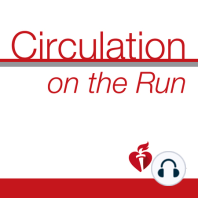17 min listen
Circulation November 16, 2021 Issue
ratings:
Length:
32 minutes
Released:
Nov 15, 2021
Format:
Podcast episode
Description
Please join authors Babken Asatryan and Anwar Chahal, and Associate Editor Ntobeko Ntusi as they discuss the Primer article "Inflammation and Immune Response in Arrhythmogenic Cardiomyopathy: State-of-the-Art Review." Dr. Carolyn Lam: Welcome to Circulation on the Run, your weekly podcast summary and backstage pass to the journal and its editors. We're your co-hosts, I'm Dr. Carolyn Lam, associate editor from the National Heart Center and Duke National University of Singapore. Dr. Greg Hundley: And I'm Dr. Greg Hundley, associate editor, director of the Pauley Heart Center at VCU Health at Richmond, Virginia. Well, Carolyn this week, our feature discussion, we're not going to go with one of our original articles, but we are going to feature a primer and a primer is a state of the art review article. The topic is going to be on arrhythmogenic cardiomyopathy and we'll be looking at the role of inflammation and the immune response in arrhythmogenic cardiomyopathy. But before we get to that feature, how about we grab a cup of coffee and talk about some of the other articles in the issue? Would you like to go first? Dr. Carolyn Lam: I would, because guess what? I'm going to be talking about prescription opioids. We know these are a major contributor to the ongoing epidemic of persistent opioid use. What do you think is the incidence after cardiac implantable electronic device procedures? Greg, let's start with a Greg Hundley quiz. I'll give you multiple choice, how about that? Do you think it is 1%, 10%, 25%. 50%? Dr. Greg Hundley: All right, Carolyn, I'm going to guess here. I'm going to go 10%. Dr. Carolyn Lam: Smart. Well, guess what? Today's paper actually gives us insight into that question, it's from Dr. Frankel from the hospital of the university of Pennsylvania and his colleagues, and these authors performed a retrospective cohort study using data from a national Administrative Claims Database from 2004 to 2018 of patients undergoing cardiac implantable electronic device procedures. Adult patients were included if they were opioid naive during the 180 day period before the procedure and did not undergo another procedure with anesthesia in the following 180 days. Dr. Carolyn Lam: Persistent opioid use, which is what we're interested in, was defined by filling an additional opioid prescription more than 30 days following the procedure. So, here's your answer. Of the more than 143,000 patients meeting these inclusion criteria, 11%, so you were right Greg, 11% filled an opioid prescription within 14 days of surgery. Among these patients, persistent opioid use occurred in 12.4% of patients, 30 to 180 days after surgery. The likelihood for developing persistent opioid use was increased for patients who had a history of drug abuse, pre-operative muscle relaxant or benzodiazepine use or opioid use in the prior five years. Also, patients who have prescribed more than 135 milligrams of oral morphine equivalence had a significantly increased risk of persistent opioid use. Dr. Carolyn Lam: Now, this is important because all physicians who perform cardiac implantable electronic device procedures and care for these patients should be aware of the risk of persistent opioid use. This is discussing in editorial by Dr. Kandil from UT Southwestern. Dr. Greg Hundley: Very interesting Carolyn, so connecting sometimes the prescription use of opioids after cardiac implantable electronic devices. Great presentation. Well, my first paper comes to us from the world of preclinical science and it's from our prior editor in chief Dr. Joseph Loscalzo from Brigham and Women's Hospital and the Harvard Medical School. So Carolyn, interferon gamma, producing CD4 positive and CD8 positive T-lymphocytes, have been identified as the predominant pathological cell subsets in human atherosclerotic plaques. Dr. Greg Hundley: While the immunological consequences of these cells have been extensively evaluated, their interferon gamma mediated metabolic effects on end
Released:
Nov 15, 2021
Format:
Podcast episode
Titles in the series (100)
Circulation January 24, 2017 Issue: Circulation Weekly: Your Weekly Summary & Backstage Pass To The Journal by Circulation on the Run
